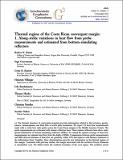Por favor, use este identificador para citar o enlazar a este item:
http://hdl.handle.net/10261/80925COMPARTIR / EXPORTAR:
 SHARE SHARE
 CORE
BASE CORE
BASE
|
|
| Visualizar otros formatos: MARC | Dublin Core | RDF | ORE | MODS | METS | DIDL | DATACITE | |

| Título: | Thermal regime of the Costa Rican convergent margin: 1. Along-strike variations in heat flow from probe measurements and estimated from bottom-simulating reflectors |
Autor: | Harris, Robert N.; Grevemeyer, Ingo; Ranero, César R. CSIC ORCID; Villinger, Heinrich; Barckhausen, Udo; Henke, Thomas; Mueller, Christian; Neben, Soenke | Palabras clave: | Subduction zones Heat flow Fluid flow Middle America Trench |
Fecha de publicación: | 15-dic-2010 | Editor: | American Geophysical Union | Citación: | Geochemistry, Geophysics, Geosystems 11(12): Q12S28 (2010) | Resumen: | The thermal structure of convergent margins provides information related to the tectonics, geodynamics, metamorphism, and fluid flow of active plate boundaries. We report 176 heat flow measurements made with a violin bow style probe across the Costa Rican margin at the Middle America Trench. The probe measurements are collocated with seismic reflection lines. These seismic reflection lines show widespread distribution of bottom-simulating reflectors (BSRs). To extend the spatial coverage of heat flow measurements we estimate heat flow from the depth of BSRs. Comparisons between probe measurements and BSR-derived estimates of heat flow are generally within 10% and improve with distance landward of the deformation front. Together, these determinations provide new information on the thermal regime of this margin. Consistent with previous studies, the margin associated with the northern Nicoya Peninsula is remarkably cool. We define better the southern boundary of the cool region. The northern extent of the cool region remains poorly determined. A regional trend of decreasing heat flow landward of the deformation front is apparent, consistent with the downward advection of heat by the subducting Cocos Plate. High wave number variability at a scale of 5–10 km is significantly greater than the measurement uncertainty and is greater south of the northern Nicoya Peninsula. These heat flow anomalies vary between approximately 20 and 60 mW m−2 and are most likely due to localized fluid flow through mounds and faults on the margin. Simple one-dimensional models show that these anomalies are consistent with flow rates of 7–15 mm yr−1. Across the margin toe variability is significant and likely due to fluid flow through deformation structures associated with the frontal sedimentary prism | Descripción: | 21 pages, 9 figures, 1 table | Versión del editor: | https://doi.org/10.1029/2010GC003272 | URI: | http://hdl.handle.net/10261/80925 | DOI: | 10.1029/2010GC003272 | Identificadores: | doi: 10.1029/2010GC003272 issn: 1525-2027 |
| Aparece en las colecciones: | (ICM) Artículos |
Ficheros en este ítem:
| Fichero | Descripción | Tamaño | Formato | |
|---|---|---|---|---|
| Harris_et_al_2010.pdf | 4,37 MB | Adobe PDF |  Visualizar/Abrir |
CORE Recommender
SCOPUSTM
Citations
24
checked on 12-abr-2024
WEB OF SCIENCETM
Citations
25
checked on 25-feb-2024
Page view(s)
334
checked on 19-abr-2024
Download(s)
301
checked on 19-abr-2024
Google ScholarTM
Check
Altmetric
Altmetric
NOTA: Los ítems de Digital.CSIC están protegidos por copyright, con todos los derechos reservados, a menos que se indique lo contrario.
